- Home
- Quizzes
- My Quiz Activity
- Newsletters
- Sports Betting
- MY FAVORITES
- Add Sports/Teams
- SPORTS
-
NFL
- NFL Home
- Arizona Cardinals
- Atlanta Falcons
- Baltimore Ravens
- Buffalo Bills
- Carolina Panthers
- Chicago Bears
- Cincinnati Bengals
- Cleveland Browns
- Dallas Cowboys
- Denver Broncos
- Detroit Lions
- Green Bay Packers
- Houston Texans
- Indianapolis Colts
- Jacksonville Jaguars
- Kansas City Chiefs
- Las Vegas Raiders
- Los Angeles Chargers
- Los Angeles Rams
- Miami Dolphins
- Minnesota Vikings
- New England Patriots
- New Orleans Saints
- New York Jets
- New York Giants
- Philadelphia Eagles
- Pittsburgh Steelers
- San Francisco 49ers
- Seattle Seahawks
- Tampa Bay Buccaneers
- Tennessee Titans
- Washington Commanders
-
MLB
- MLB Home
- Arizona Diamondbacks
- Atlanta Braves
- Baltimore Orioles
- Boston Red Sox
- Chicago White Sox
- Chicago Cubs
- Cincinnati Reds
- Cleveland Guardians
- Colorado Rockies
- Detroit Tigers
- Houston Astros
- Kansas City Royals
- Los Angeles Angels
- Los Angeles Dodgers
- Miami Marlins
- Milwaukee Brewers
- Minnesota Twins
- New York Yankees
- New York Mets
- Oakland Athletics
- Philadelphia Phillies
- Pittsburgh Pirates
- San Diego Padres
- San Francisco Giants
- Seattle Mariners
- St. Louis Cardinals
- Tampa Bay Rays
- Texas Rangers
- Toronto Blue Jays
- Washington Nationals
-
NBA
- NBA Home
- Atlanta Hawks
- Boston Celtics
- Brooklyn Nets
- Charlotte Hornets
- Chicago Bulls
- Cleveland Cavaliers
- Dallas Mavericks
- Denver Nuggets
- Detroit Pistons
- Golden State Warriors
- Houston Rockets
- Indiana Pacers
- Los Angeles Clippers
- Los Angeles Lakers
- Memphis Grizzlies
- Miami Heat
- Milwaukee Bucks
- Minnesota Timberwolves
- New Orleans Pelicans
- New York Knicks
- Oklahoma City Thunder
- Orlando Magic
- Philadelphia 76ers
- Phoenix Suns
- Portland Trail Blazers
- Sacramento Kings
- San Antonio Spurs
- Toronto Raptors
- Utah Jazz
- Washington Wizards
-
NHL
- NHL Home
- Anaheim Ducks
- Arizona Coyotes
- Boston Bruins
- Buffalo Sabres
- Calgary Flames
- Carolina Hurricanes
- Chicago Blackhawks
- Colorado Avalanche
- Columbus Blue Jackets
- Dallas Stars
- Detroit Red Wings
- Edmonton Oilers
- Florida Panthers
- Los Angeles Kings
- Minnesota Wild
- Montreal Canadiens
- Nashville Predators
- New Jersey Devils
- New York Islanders
- New York Rangers
- Ottawa Senators
- Philadelphia Flyers
- Pittsburgh Penguins
- San Jose Sharks
- Seattle Kraken
- St. Louis Blues
- Tampa Bay Lightning
- Toronto Maple Leafs
- Vancouver Canucks
- Vegas Golden Knights
- Washington Capitals
- Winnipeg Jets
- NCAAF
- NCAAM
- Boxing
- Entertainment
- Lifestyle
- Golf
- MMA
- Soccer
- Tennis
- Wrestling
- More Sports
- RESOURCES
- My Account
- YB on Facebook
- YB on Twitter
- YB on Flipboard
- Contact Us
- Privacy Policy
- Terms of Service
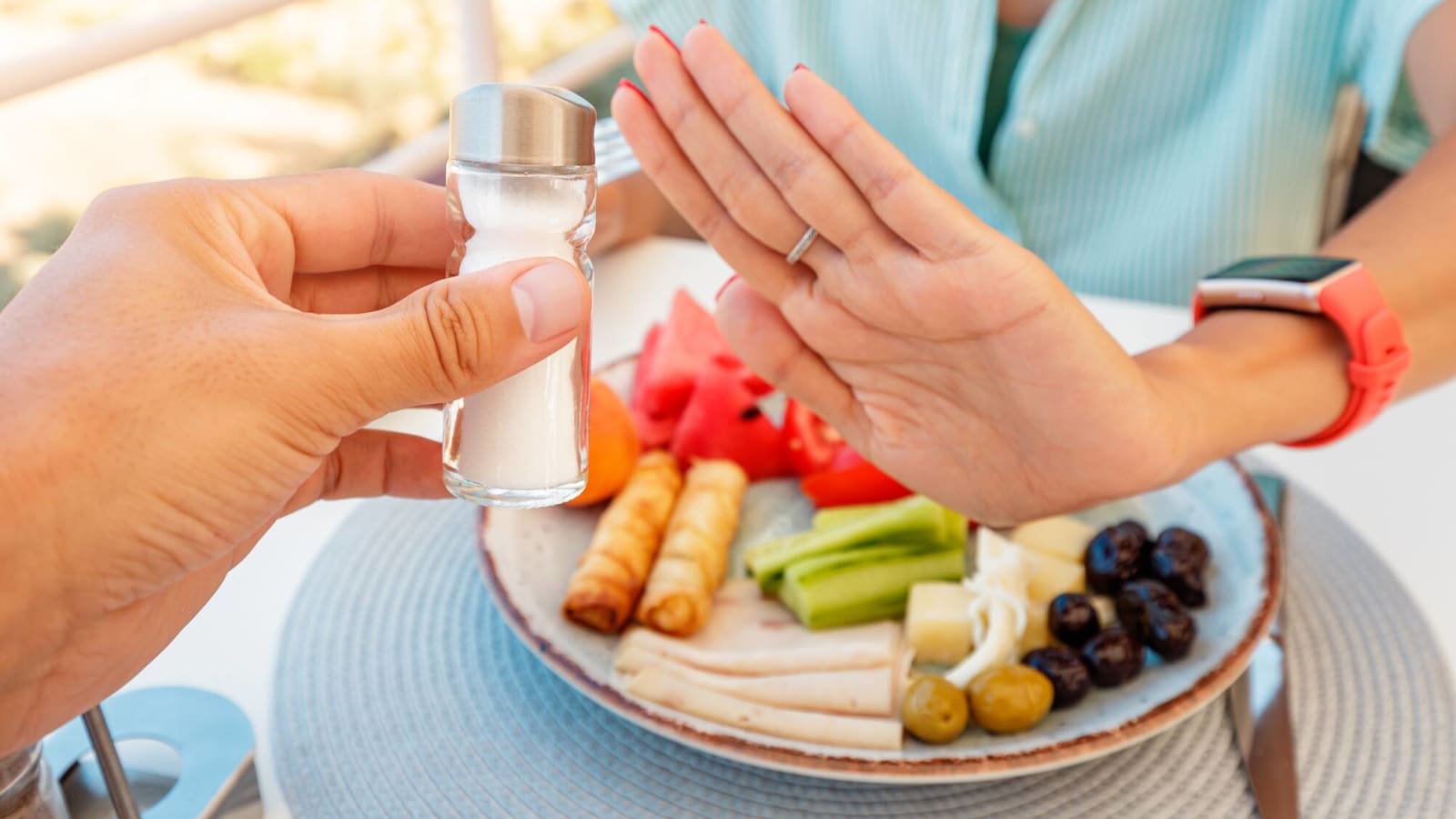
Pass on the salt: 22 low-sodium foods
Monitoring the sodium levels in your diet can be tricky because, unlike sugary foods that taste sweet, not all foods high in sodium taste salty. Sodium can hide in meat, bread, and seasonings, and too much can lead to high blood pressure and other health issues. Pass (on) the salt with these 22 low-sodium foods.
Chicken

If you prefer a plentiful portion of meat-based protein in your diet, choose chicken. Not only does it have the most protein, but it also has the least sodium. A 4-oz serving of chicken breast contains just 84 mg of sodium.
Eggs

It’s common to add salt and pepper to eggs to improve the taste because eggs alone do not contain much sodium. A single egg has only 62 mg of sodium, most of which is in the white. (The yolks only have about 8 mg each!)
Fresh fish
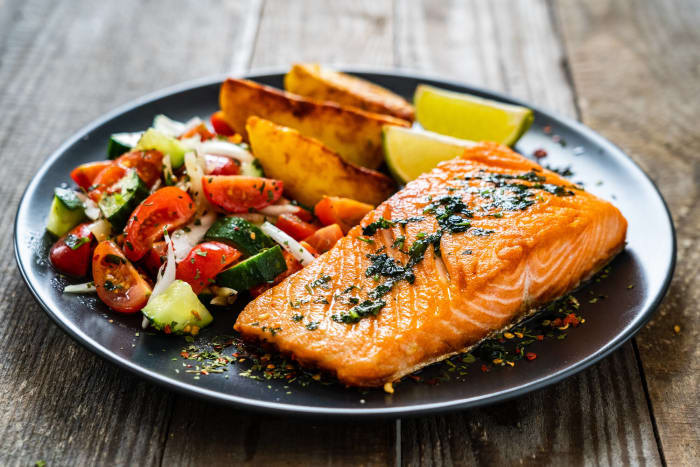
There are plenty of low-sodium fish in the sea, but when it comes to the preparation and preservation, you must choose wisely. Canned anchovies and sardines are packaged in salt and retain much of it — in fact, a single small anchovy can contain a startling 150 mg! On the other hand (or fin), for every 4-oz serving of fresh fish, salmon only has 69 mg, whitefish has 73 mg, and mahi mahi has 100 mg, to name just a few options.
Fresh mushrooms
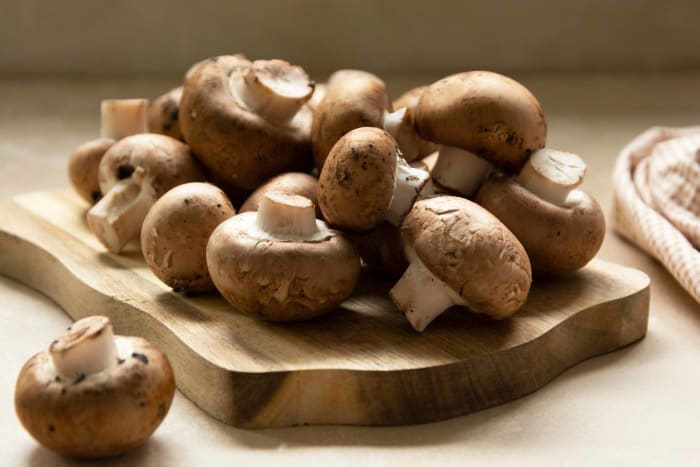
Whatever mushrooms you fancy — from button, crimini, and portobello to shiitake, porcini, and enoki — you won’t find much sodium in them. Of course, that statement is limited to fresh mushrooms. A serving of canned mushrooms clocks in around 350 mg unless you can get your grubs on a no-salt-added version, which nearly eliminates the sodium content.
Fresh vegetables

Regarding raw vegetables, the offenders with the most sodium are artichokes and beets, which contain 100-120 mg of sodium per cup. That’s a fancy way of saying no matter which raw veggies you choose, they will be low in sodium. And some varieties — including asparagus, cucumber, eggplant, green beans, and yellow squash — are considered sodium-free!
Frozen vegetables

Some frozen foods feature added sodium, but most frozen veggies do not. Just avoid anything that’s marketed as seasoned or sauced (as these are sneaky sources of salt), and check the label to be sure. Keep in mind that some vegetables will naturally contain salt, so you’ll want to specifically look at both the ingredients list and the nutrition facts.
Fruit

Fruit, whether fresh, frozen, canned, or dried, is almost always a sodium-safe option. The only exceptions are goji berries, which have about 300 mg of sodium per 100-gram serving, and olives, which have 18-63 mg of sodium per olive, depending on the variety.
Herbs

Like vegetables, herbs are plants and have naturally low sodium levels. One of the most popular herbs, parsley, has 34 mg per cup. Cilantro, oregano, rosemary, sage, and thyme also have sodium, but significantly less than parsley, boasting 2 mg per cup or less. And lovers of Italian food will be delighted to discover that basil is sodium-free!
Lean beef
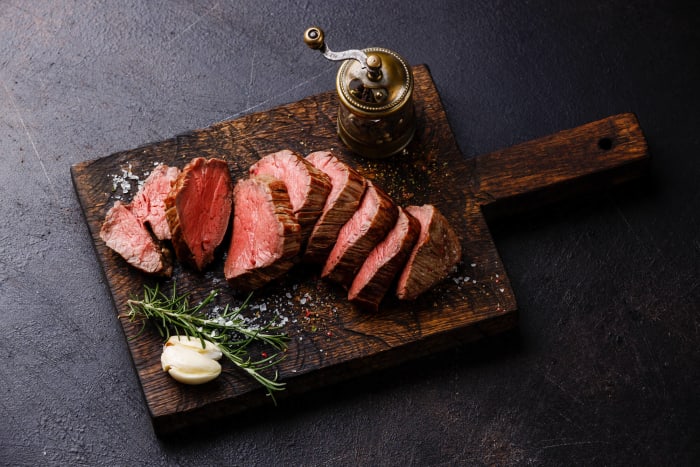
Not all beef is bad when it comes to sodium. A large beef sausage could saddle you with more than 1,000 mg of sodium, 4 ounces of ground beef, and some steaks clock in at 450 mg each, and the same serving of roast beef or beef brisket has about 250 mg. But if you opt for beef tenderloin, beef chuck, or beef ribs, a serving serves up fewer than 80 mg.
Lean pork

The usual suspects of salty meat include bacon, sausage, and ham…but not all pork products are created equal. Lean cuts of pork contain very little sodium, and we have the numbers to exonerate them. A 4-oz pork chop or pork sparerib contains about 85 mg, while the same serving of pork tenderloin contains only 64 mg. We rest our case.
Low-sodium canned beans
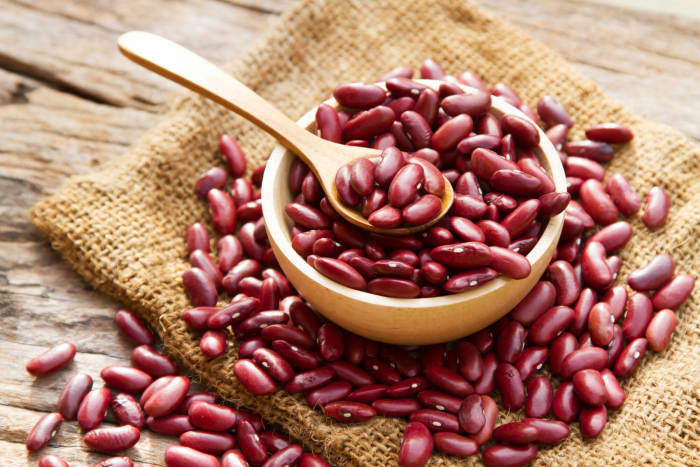
Cans of beans are like little sodium bombs thanks to all the salt added as a preservative. When we shop at the grocery store, we opt for cans marked as “low sodium,” “no salt added,” or “heart-healthy.” To compare: A 130-gram serving of black beans (about a cup) contains 400 mg of sodium, but the low-sodium version has only 130 mg, and the no-salt-added kind comes with only 2 mg! For kidney beans, it’s 260 mg, 120 mg, and 10 mg, respectively.
Low-sodium canned veggies

Canned vegetables and canned beans come with the same caution: Beware of the sodium! For example, corn doesn’t contain a lot of natural salt — only 28 mg per cup — but a cup of canned corn has nearly 450 mg of sodium! Opt for the no-salt-added variety and you’ll cut that down to 25 mg. Likewise, peas are nearly sodium-free, but a cup of canned peas has 420 mg, while the version with no salt added has only 8 mg.
Milk

Dairy can sometimes sneak salt into your diet, but most milk is relatively low in sodium. Whether you opt for whole, 2%, 1%, or skim, you’re looking at about 100 mg of sodium per 8-oz serving. As for dairy alternatives: almond, oat, and soy milk are comparable, but if you’re looking for something even lower in sodium, opt for coconut milk, which only has about 25 mg per serving.
Popcorn

Popcorn can be quite unhealthy when it’s loaded with salt and butter, but the corn itself is actually a diet-friendly food. A 1.5-oz serving (about 5 cups when popped) not only clocks in at a low 169 calories but also contains just 2 mg of sodium. Shake that salt on scrupulously and you’re still looking at a low-sodium snack.
Potatoes

Many potato-based sides, including fries, tater tots, hash browns, baked potatoes, and mashed potatoes, are high in sodium. However, that’s due to the added salt and toppings, as the potatoes themselves — whether they are russet, red, yellow, or white — are sodium-free. Even sweet potatoes, which are root vegetables but not actually potatoes, are low in sodium, containing only 73 mg per cup.
Rinsed beans

Most of us get our beans from a can, which is a red flag for sodium. But as we mentioned before, it’s not the beans that contain so much salt, it’s the water in which they’re preserved. If you can’t get your hands on a low-sodium variety, simply rinse your beans before consuming them —or, better yet, rinse and soak them in water. A 30-second rinse can remove about 20% of the sodium, but a half-hour soak could cut the salt content in half.
Soft cheeses

Not all soft cheeses are safely low-sodium, but opting against hard cheeses is a safe bet. Per ounce, Brie has 178 mg, cottage cheese has 103 mg, cream cheese has 91 mg, ricotta has 24 mg, mascarpone has 10 mg, and fresh mozzarella has only 4 mg. By comparison, parmesan has 433 mg, blue cheese has 395 mg, romano has 340 mg, and feta has 316 mg.
Spices

Some seasonings are salt-based, but most spices are safe. In fact, black pepper, cayenne, celery seed, cinnamon, cumin, garlic powder, nutmeg, onion powder, oregano, paprika, and numerous others are either completely sodium-free or have fewer than 10 mg per tablespoon. Just be careful, as there are a few exceptions. A tablespoon of chili powder contains 131 mg of sodium, and the same serving of capers contains 238 mg!
Shrimp

Many shellfish contain large amounts of sodium, even if they don’t live in saltwater. Four ounces of clams or crabs have about 1,300 mg, while the same serving of scallops has 750 mg, oysters have 475 mg, mussels have 450 mg, and squid, octopus, and lobster have 350-400 mg. One bright spot in the sea? Shrimp. Depending on the size, each fresh shrimp only contains 7-10 mg of sodium.
Turkey

Like chicken, turkey is a lean, low-sodium protein. Four ounces of turkey breast contains 71 mg of sodium, and a drumstick serves up slightly more salt than that, but still a negligible amount. Just avoid deli-style turkey, as a single serving can contain upwards of 1,000 mg. If you’re going the latter route, opt for varieties labeled as low-sodium.
Whole-wheat or corn-based breads

Bread and bread-adjacent products are surprising sources of sodium, as they’re not salty-tasting foods. Two slices of white bread can contain up to 600 mg of sodium, but whole-wheat varieties can cut the sodium in half. However, this is not a hard-and-fast rule, so check the nutrition label before buying. You can similarly keep sodium in check by opting for whole wheat tortillas over flour tortillas, but if you really want to cut down on the salt, opt for the corn-based kind, which only has 10-20 mg of sodium, depending on the size.
Yogurt

What we previously said about milk applies here: Yogurt is a sodium-safe food, and it really doesn’t matter what kind you buy. Whether you prefer Greek or traditional yogurt, full-fat or fat-free, or plain or flavored, you’ll be consuming 20-100 mg of sodium per serving.
More must-reads:
- Tracking Aston Villa's wild journey to Champions League
- Anthony Edwards explains why he 'can't be mad' about Game 5 loss
- The 'Super Bowl starting QBs' quiz
Breaking News
Customize Your Newsletter
 +
+
Get the latest news and rumors, customized to your favorite sports and teams. Emailed daily. Always free!
Use of this website (including any and all parts and
components) constitutes your acceptance of these
Terms of Service and Privacy Policy.

